|
|
Isfahan
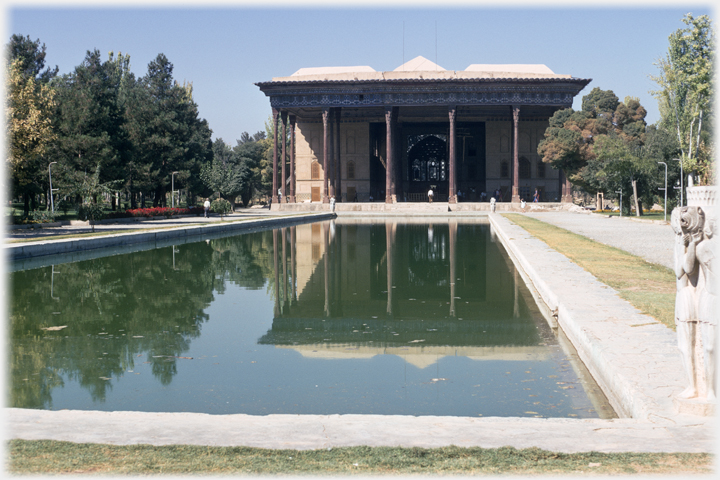 The Chehel Sotoun palace was built by Shah Abbas II in 1647 to receive dignitaries and ambassadors. The stately pavilion sits in fine gardens, and looks out on a pool in which its 20 slender columns are reflected, giving it its name the '40 column palace'.
Isfahan rightly claims to be one of the most beautiful cities in the world; naturally in some eyes it is the most beautiful. The claim is based on its architecture rather than topography, although the views of the mountains always give a thrill as Isfahan is no exception to the rule that Iranian cities lie next to mountain ranges from where their good water supply comes.
The Chehel Sotoun palace was built by Shah Abbas II in 1647 to receive dignitaries and ambassadors. The stately pavilion sits in fine gardens, and looks out on a pool in which its 20 slender columns are reflected, giving it its name the '40 column palace'.
Isfahan rightly claims to be one of the most beautiful cities in the world; naturally in some eyes it is the most beautiful. The claim is based on its architecture rather than topography, although the views of the mountains always give a thrill as Isfahan is no exception to the rule that Iranian cities lie next to mountain ranges from where their good water supply comes.
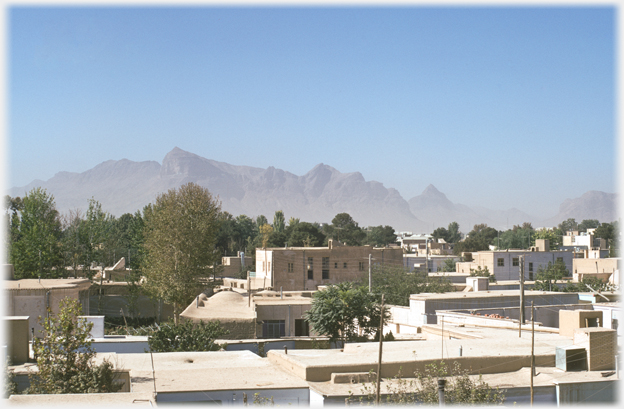 In the early 70s the cityscape was still of the traditional mud packed houses with mountains beyond
In the early 70s the cityscape was still of the traditional mud packed houses with mountains beyond
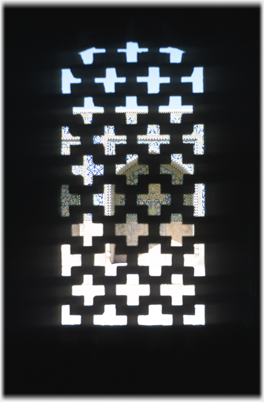 Stone windows like these keep out intruders while allowing the air to circulate; often the silhouettes are striking
Stone windows like these keep out intruders while allowing the air to circulate; often the silhouettes are striking
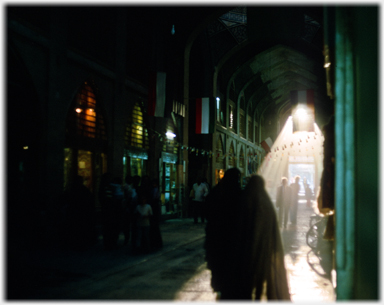 The main bazaar offers shelter from the heat, although here the sun has found a way in and reveals the legs of a woman in a full length chador (Iranian veil)
The cities of Iran, being on a high plateau at around 5,000 ft (1,700 m), have pleasant climates, with a mean temperature in the summer of around 30 degrees and humidity of 20% or even less. The lack of precipitation allowed the large scale use of compacted mud walls.
Isfahan (also transcribed as Esfahan, Ispahan and Hispahan) became the capital of Iran when it was moved from Qazvin in 1598 by Shah Abbas I (Abbas the Great). This led to the golden age of the city when an extraordinary wealth of architectural gems were created under him and his successors.
The main bazaar offers shelter from the heat, although here the sun has found a way in and reveals the legs of a woman in a full length chador (Iranian veil)
The cities of Iran, being on a high plateau at around 5,000 ft (1,700 m), have pleasant climates, with a mean temperature in the summer of around 30 degrees and humidity of 20% or even less. The lack of precipitation allowed the large scale use of compacted mud walls.
Isfahan (also transcribed as Esfahan, Ispahan and Hispahan) became the capital of Iran when it was moved from Qazvin in 1598 by Shah Abbas I (Abbas the Great). This led to the golden age of the city when an extraordinary wealth of architectural gems were created under him and his successors.
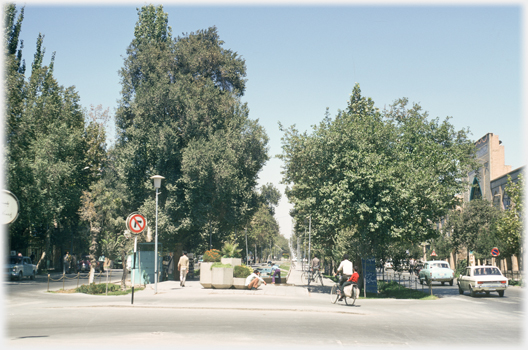 Chahar Bagh is the main road in Isfahan, it is just over one and a half kilometres long; its name - four gardens - comes from the design of the area between the carriageways
Chahar Bagh is the main road in Isfahan, it is just over one and a half kilometres long; its name - four gardens - comes from the design of the area between the carriageways
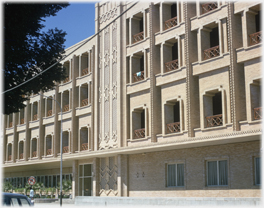 Madrasas are residential theological colleges which were started in eastern Iran in the tenth century, and spread across the Islamic world in the following hundred years. This is a modern version, the rooms are deeply inset into the building to keep away from the sun
Madrasas are residential theological colleges which were started in eastern Iran in the tenth century, and spread across the Islamic world in the following hundred years. This is a modern version, the rooms are deeply inset into the building to keep away from the sun
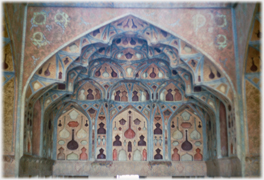 In the Music Hall of the Chehel Sotoun Palace the walls and ceilings are decorated with these plaster panels that are designed to enhance the acoustics
In the Music Hall of the Chehel Sotoun Palace the walls and ceilings are decorated with these plaster panels that are designed to enhance the acoustics
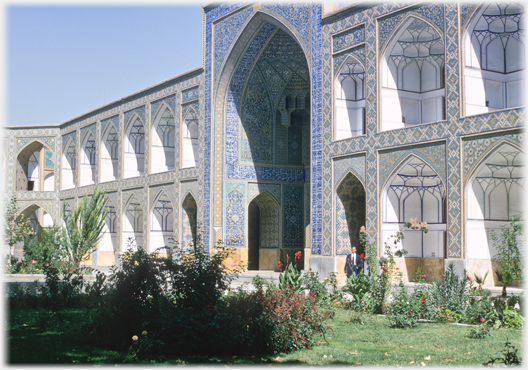 This magnificent iwan, and the madrasa of which it is part, were the last great works of the Safavid dynasty. This madrasa, a caravanserai and the bazaar were conceived as one unit fulfilling a whole range of social purposes in a single complex
This magnificent iwan, and the madrasa of which it is part, were the last great works of the Safavid dynasty. This madrasa, a caravanserai and the bazaar were conceived as one unit fulfilling a whole range of social purposes in a single complex
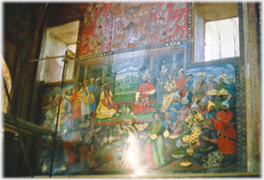 This Fresco on a wall of the Chehel Sotoun Palace shows a reception ceremony for Shah Tahmasb Safavid. Many of the Palace's frescos have been 'taken to' or 'stolen by' (depending on your point of view) western museums
This Fresco on a wall of the Chehel Sotoun Palace shows a reception ceremony for Shah Tahmasb Safavid. Many of the Palace's frescos have been 'taken to' or 'stolen by' (depending on your point of view) western museums
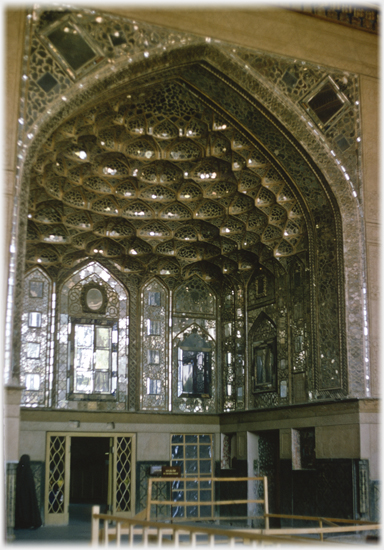
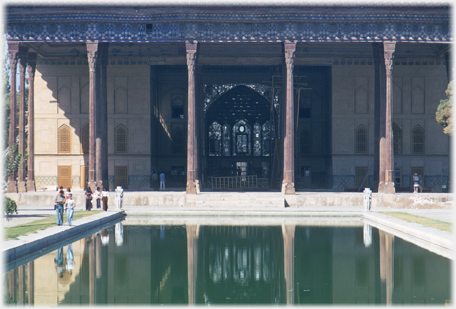 The main reception area and iwan of the Chehel Sotoun Palace
In the picture to the right three archetypal elements of Iranian architecture can be seen: in the iwan (three sided room), the ornamental vaulting is called a 'muqarnas', and it is studded with small mirrors.
The main reception area and iwan of the Chehel Sotoun Palace
In the picture to the right three archetypal elements of Iranian architecture can be seen: in the iwan (three sided room), the ornamental vaulting is called a 'muqarnas', and it is studded with small mirrors.
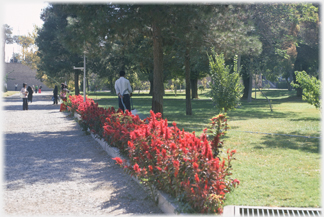 Watering in the gardens which adjoin the Chehel Sotoun Palace, these are smaller now but originally extended to six square kilometres
These gardens are part of the 17 Persian Gardens which, although dispersed, form the one Cultural Heritage site - Persian Gardens
Watering in the gardens which adjoin the Chehel Sotoun Palace, these are smaller now but originally extended to six square kilometres
These gardens are part of the 17 Persian Gardens which, although dispersed, form the one Cultural Heritage site - Persian Gardens
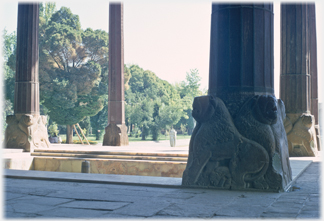 Carved lions sit at the base of the pillars
Carved lions sit at the base of the pillars
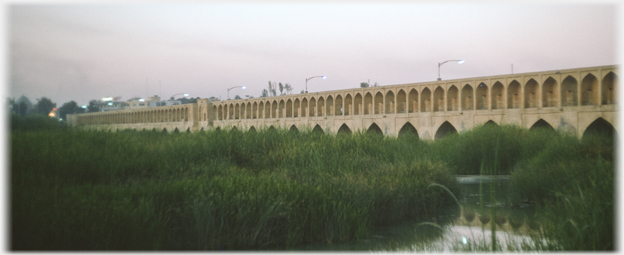 The Allahverdi Khan Bridge (1599) has 33 arches and is named after a general of the late sixteenth century
The Allahverdi Khan Bridge (1599) has 33 arches and is named after a general of the late sixteenth century
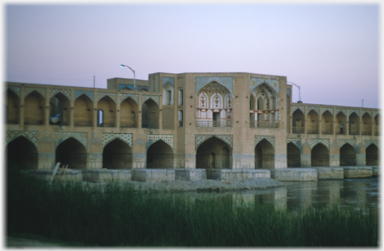 The Khaju Bridge (1650) was not only designed as a bridge and weir...
The Khaju Bridge (1650) was not only designed as a bridge and weir...
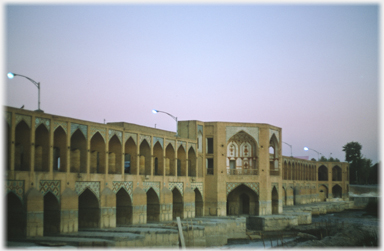 ...but also provided a place for public meetings, and the central room was used by the Shah
...but also provided a place for public meetings, and the central room was used by the Shah
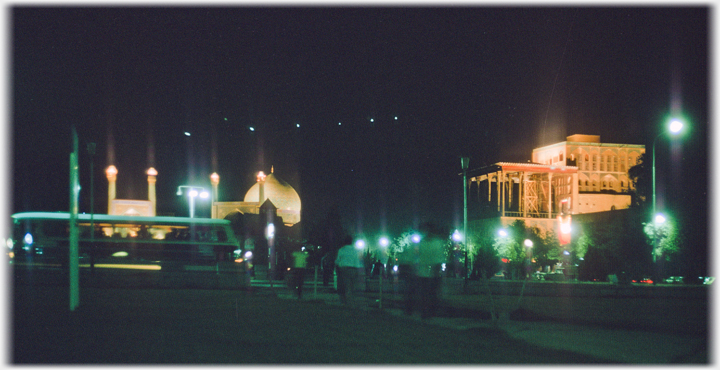 At the centre of Isfahan is the Naqsh-e-Jahan Square, a huge area over half a kilometre long and 160 metres wide, it was constructed at the beginning of the eighteenth century, in the Safavid dynasty, and is designated a world heritage site. This night picture shows two of the most important buildings around its periphery: to the left the Shah Mosque and to the right the Ali Qapu Palace.
At the centre of Isfahan is the Naqsh-e-Jahan Square, a huge area over half a kilometre long and 160 metres wide, it was constructed at the beginning of the eighteenth century, in the Safavid dynasty, and is designated a world heritage site. This night picture shows two of the most important buildings around its periphery: to the left the Shah Mosque and to the right the Ali Qapu Palace.
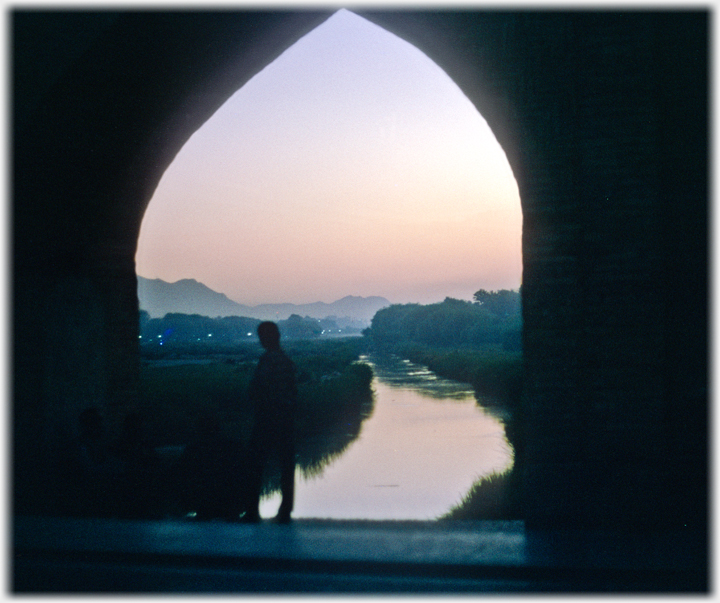 The Khaju Bridge crosses the Zayandeh River, connecting the Zoroastrian Quarter on the south bank to the Khaju area on the north. The 24 arches now provide delightful meeting places for all members of the community
The next page
has more pictures from Isfahan with images of the main mosques. The lead picture shows the extraordinary inside of the dome of the Lotf-Allah Mosque.
The Khaju Bridge crosses the Zayandeh River, connecting the Zoroastrian Quarter on the south bank to the Khaju area on the north. The 24 arches now provide delightful meeting places for all members of the community
The next page
has more pictures from Isfahan with images of the main mosques. The lead picture shows the extraordinary inside of the dome of the Lotf-Allah Mosque.
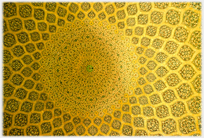

Saturday 18th June 2016

Go to the Picture Posting contents page
Return to the top
|
|
 The Chehel Sotoun palace was built by Shah Abbas II in 1647 to receive dignitaries and ambassadors. The stately pavilion sits in fine gardens, and looks out on a pool in which its 20 slender columns are reflected, giving it its name the '40 column palace'.
Isfahan rightly claims to be one of the most beautiful cities in the world; naturally in some eyes it is the most beautiful. The claim is based on its architecture rather than topography, although the views of the mountains always give a thrill as Isfahan is no exception to the rule that Iranian cities lie next to mountain ranges from where their good water supply comes.
The Chehel Sotoun palace was built by Shah Abbas II in 1647 to receive dignitaries and ambassadors. The stately pavilion sits in fine gardens, and looks out on a pool in which its 20 slender columns are reflected, giving it its name the '40 column palace'.
Isfahan rightly claims to be one of the most beautiful cities in the world; naturally in some eyes it is the most beautiful. The claim is based on its architecture rather than topography, although the views of the mountains always give a thrill as Isfahan is no exception to the rule that Iranian cities lie next to mountain ranges from where their good water supply comes.
 In the early 70s the cityscape was still of the traditional mud packed houses with mountains beyond
In the early 70s the cityscape was still of the traditional mud packed houses with mountains beyond
 Stone windows like these keep out intruders while allowing the air to circulate; often the silhouettes are striking
Stone windows like these keep out intruders while allowing the air to circulate; often the silhouettes are striking
 The main bazaar offers shelter from the heat, although here the sun has found a way in and reveals the legs of a woman in a full length chador (Iranian veil)
The cities of Iran, being on a high plateau at around 5,000 ft (1,700 m), have pleasant climates, with a mean temperature in the summer of around 30 degrees and humidity of 20% or even less. The lack of precipitation allowed the large scale use of compacted mud walls.
Isfahan (also transcribed as Esfahan, Ispahan and Hispahan) became the capital of Iran when it was moved from Qazvin in 1598 by Shah Abbas I (Abbas the Great). This led to the golden age of the city when an extraordinary wealth of architectural gems were created under him and his successors.
The main bazaar offers shelter from the heat, although here the sun has found a way in and reveals the legs of a woman in a full length chador (Iranian veil)
The cities of Iran, being on a high plateau at around 5,000 ft (1,700 m), have pleasant climates, with a mean temperature in the summer of around 30 degrees and humidity of 20% or even less. The lack of precipitation allowed the large scale use of compacted mud walls.
Isfahan (also transcribed as Esfahan, Ispahan and Hispahan) became the capital of Iran when it was moved from Qazvin in 1598 by Shah Abbas I (Abbas the Great). This led to the golden age of the city when an extraordinary wealth of architectural gems were created under him and his successors.
 Chahar Bagh is the main road in Isfahan, it is just over one and a half kilometres long; its name - four gardens - comes from the design of the area between the carriageways
Chahar Bagh is the main road in Isfahan, it is just over one and a half kilometres long; its name - four gardens - comes from the design of the area between the carriageways
 Madrasas are residential theological colleges which were started in eastern Iran in the tenth century, and spread across the Islamic world in the following hundred years. This is a modern version, the rooms are deeply inset into the building to keep away from the sun
Madrasas are residential theological colleges which were started in eastern Iran in the tenth century, and spread across the Islamic world in the following hundred years. This is a modern version, the rooms are deeply inset into the building to keep away from the sun
 In the Music Hall of the Chehel Sotoun Palace the walls and ceilings are decorated with these plaster panels that are designed to enhance the acoustics
In the Music Hall of the Chehel Sotoun Palace the walls and ceilings are decorated with these plaster panels that are designed to enhance the acoustics
 This magnificent iwan, and the madrasa of which it is part, were the last great works of the Safavid dynasty. This madrasa, a caravanserai and the bazaar were conceived as one unit fulfilling a whole range of social purposes in a single complex
This magnificent iwan, and the madrasa of which it is part, were the last great works of the Safavid dynasty. This madrasa, a caravanserai and the bazaar were conceived as one unit fulfilling a whole range of social purposes in a single complex
 This Fresco on a wall of the Chehel Sotoun Palace shows a reception ceremony for Shah Tahmasb Safavid. Many of the Palace's frescos have been 'taken to' or 'stolen by' (depending on your point of view) western museums
This Fresco on a wall of the Chehel Sotoun Palace shows a reception ceremony for Shah Tahmasb Safavid. Many of the Palace's frescos have been 'taken to' or 'stolen by' (depending on your point of view) western museums

 The main reception area and iwan of the Chehel Sotoun Palace
In the picture to the right three archetypal elements of Iranian architecture can be seen: in the iwan (three sided room), the ornamental vaulting is called a 'muqarnas', and it is studded with small mirrors.
The main reception area and iwan of the Chehel Sotoun Palace
In the picture to the right three archetypal elements of Iranian architecture can be seen: in the iwan (three sided room), the ornamental vaulting is called a 'muqarnas', and it is studded with small mirrors.
 Watering in the gardens which adjoin the Chehel Sotoun Palace, these are smaller now but originally extended to six square kilometres
These gardens are part of the 17 Persian Gardens which, although dispersed, form the one Cultural Heritage site - Persian Gardens
Watering in the gardens which adjoin the Chehel Sotoun Palace, these are smaller now but originally extended to six square kilometres
These gardens are part of the 17 Persian Gardens which, although dispersed, form the one Cultural Heritage site - Persian Gardens
 Carved lions sit at the base of the pillars
Carved lions sit at the base of the pillars
 The Allahverdi Khan Bridge (1599) has 33 arches and is named after a general of the late sixteenth century
The Allahverdi Khan Bridge (1599) has 33 arches and is named after a general of the late sixteenth century
 The Khaju Bridge (1650) was not only designed as a bridge and weir...
The Khaju Bridge (1650) was not only designed as a bridge and weir...
 ...but also provided a place for public meetings, and the central room was used by the Shah
...but also provided a place for public meetings, and the central room was used by the Shah
 At the centre of Isfahan is the Naqsh-e-Jahan Square, a huge area over half a kilometre long and 160 metres wide, it was constructed at the beginning of the eighteenth century, in the Safavid dynasty, and is designated a world heritage site. This night picture shows two of the most important buildings around its periphery: to the left the Shah Mosque and to the right the Ali Qapu Palace.
At the centre of Isfahan is the Naqsh-e-Jahan Square, a huge area over half a kilometre long and 160 metres wide, it was constructed at the beginning of the eighteenth century, in the Safavid dynasty, and is designated a world heritage site. This night picture shows two of the most important buildings around its periphery: to the left the Shah Mosque and to the right the Ali Qapu Palace.
 The Khaju Bridge crosses the Zayandeh River, connecting the Zoroastrian Quarter on the south bank to the Khaju area on the north. The 24 arches now provide delightful meeting places for all members of the community
The next page
has more pictures from Isfahan with images of the main mosques. The lead picture shows the extraordinary inside of the dome of the Lotf-Allah Mosque.
The Khaju Bridge crosses the Zayandeh River, connecting the Zoroastrian Quarter on the south bank to the Khaju area on the north. The 24 arches now provide delightful meeting places for all members of the community
The next page
has more pictures from Isfahan with images of the main mosques. The lead picture shows the extraordinary inside of the dome of the Lotf-Allah Mosque.


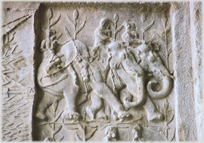 The last page had a little on ancient cultures of northern Iran
The last page had a little on ancient cultures of northern Iran
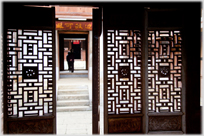 A palace in the mountains of northern Vietnam - small and homely
A palace in the mountains of northern Vietnam - small and homely
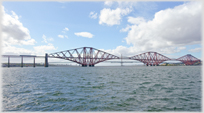 Go to some very different bridges in Scotland
Go to some very different bridges in Scotland
